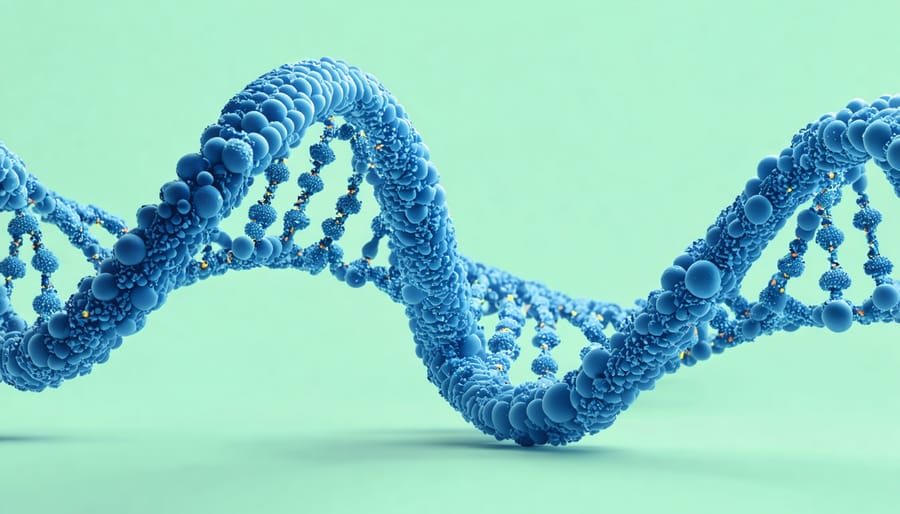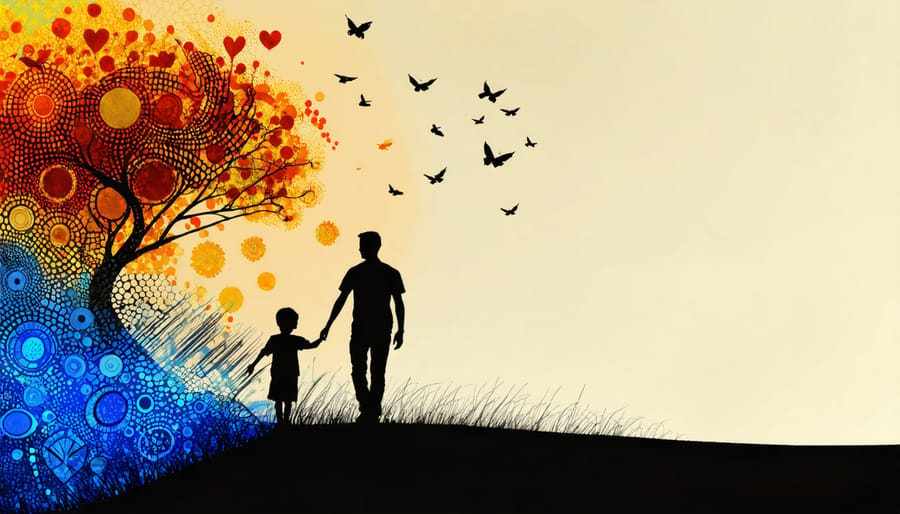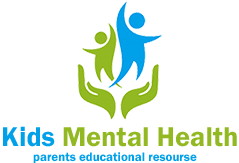The ripple effects of trauma echo through generations, shaping not just individual lives but entire family legacies. Recent breakthrough research reveals how experiences of adversity and trauma can be passed down through biological, psychological, and social pathways, fundamentally altering how future generations process stress and build relationships. Understanding intergenerational trauma opens crucial windows for healing childhood trauma and breaking cycles that have persisted across decades.
While the science behind trauma transmission may seem daunting, groundbreaking studies offer hope. Researchers have discovered that just as trauma can be inherited, so too can resilience and healing be cultivated and passed forward. From epigenetic modifications that influence stress responses to attachment patterns that shape emotional regulation, we now understand both the mechanisms of trauma transmission and the pathways toward recovery.
This emerging field represents a paradigm shift in mental health, moving beyond individual treatment to consider the broader context of family histories and collective experiences. For parents, educators, and healthcare providers, this knowledge provides powerful tools to support not just current healing but the wellbeing of generations to come.
Understanding Intergenerational Trauma
The Science Behind Trauma Transfer
Recent scientific discoveries have revealed fascinating insights into how trauma can be passed down through generations – not just through learned behaviors, but through biological changes in our genes. This process, known as epigenetics, helps explain how our experiences can influence our children’s well-being.
Think of our genes like a vast library of books. Epigenetic changes are like sticky notes that determine which books (genes) can be easily opened and read, and which remain closed. Traumatic experiences can place these sticky notes on certain genes, affecting how they function without changing the underlying genetic code.
Dr. Rachel Yehuda, a pioneering researcher in this field, found that children of Holocaust survivors showed similar stress hormone patterns to their parents, despite never experiencing the trauma directly. Similar patterns have been observed in studies of other groups who experienced significant trauma.
The biological mechanisms work in several ways. Stress hormones like cortisol can affect egg and sperm cells before conception, potentially influencing future generations. During pregnancy, a mother’s stress responses can affect the developing baby’s nervous system through the placenta. These changes can impact how future generations respond to stress, process emotions, and cope with challenges.
However, it’s crucial to remember that these biological changes aren’t permanent destiny. Our bodies and brains are remarkably adaptable, and with proper support and intervention, the effects of intergenerational trauma can be addressed and healed. Understanding these mechanisms helps us develop more effective treatments and support strategies for families affected by historical trauma.

Behavioral Patterns and Learning
When trauma affects a parent, it often influences their parenting style and the way they interact with their children. Research shows that parents who have experienced significant trauma may develop specific attachment patterns and behaviors that can be passed down to their children.
For example, Sarah, a family therapist with twenty years of experience, shares: “I’ve observed how traumatized parents might become either overly protective or emotionally distant. These behaviors, while stemming from their own pain, can shape how their children learn to cope with stress and form relationships.”
Common behavioral patterns that may emerge include:
– Difficulty setting consistent boundaries
– Heightened anxiety about child safety
– Emotional numbness or overreaction
– Challenges in expressing affection
– Inconsistent disciplinary approaches
Children naturally learn by observing and mimicking their parents’ responses to stress, fear, and uncertainty. They may internalize these coping mechanisms, even if they haven’t experienced the original trauma directly. This learning process happens both consciously and unconsciously, affecting everything from emotional regulation to relationship-building skills.
The good news is that these patterns can be identified and changed. With awareness and support, parents can learn new ways of responding to stress and relating to their children. Professional guidance, coupled with self-reflection and conscious parenting practices, can help break the cycle of intergenerational trauma and create healthier behavioral patterns for future generations.

Signs of Inherited Trauma in Children
Emotional and Behavioral Indicators
Understanding the signs of intergenerational trauma can help us provide better support for those affected. Children and adults carrying inherited trauma may exhibit various emotional and behavioral patterns that aren’t always immediately linked to family history.
Common emotional indicators include unexplained anxiety, particularly about specific situations that troubled their parents or grandparents. For instance, children of Holocaust survivors might show intense reactions to authority figures or experience persistent food insecurity despite having plenty.
Behavioral signs often manifest as:
– Difficulty forming secure attachments
– Heightened startle response
– Overprotective parenting styles
– Unexplained fears or phobias
– Strong emotional reactions to seemingly minor triggers
– Persistent feelings of guilt or shame
– Difficulty expressing emotions
Dr. Sarah Chen, a trauma specialist, notes: “What’s fascinating is how these patterns can emerge even when the original trauma wasn’t directly discussed within families. The body keeps the score, as they say.”
Parents might notice their children exhibiting anxiety about situations they themselves struggled with, creating an unconscious cycle. Teachers often observe students showing unusual responses to stress or displaying hypervigilance without clear immediate causes.
Remember that these indicators aren’t definitive proof of intergenerational trauma, but rather potential signs that warrant gentle exploration and professional support when needed.
Breaking the Cycle
Therapeutic Approaches
Several evidence-based therapeutic approaches have shown promising results in addressing intergenerational trauma. One of the most effective methods is Trauma-Focused Cognitive Behavioral Therapy (TF-CBT), which helps both parents and children understand how past experiences influence current behaviors and emotions. This approach is particularly valuable as part of the overall trauma recovery process.
Family therapy sessions that include multiple generations have proven especially beneficial, as they create a safe space for open dialogue about shared experiences and healing. These sessions often incorporate narrative therapy techniques, allowing families to rewrite their stories and break harmful patterns.
Eye Movement Desensitization and Reprocessing (EMDR) has also shown success in treating trauma across generations. This approach helps individuals process traumatic memories while developing new, healthier coping mechanisms that they can pass on to their children.
Mindfulness-based interventions, such as parent-child meditation and emotional awareness exercises, help strengthen family bonds while teaching valuable self-regulation skills. These practices can be particularly powerful when combined with attachment-based therapy, which focuses on building secure relationships between parents and children.
Support groups for families affected by intergenerational trauma provide a community of understanding and shared experiences, helping participants feel less isolated in their healing journey. These groups often incorporate elements of psychoeducation, teaching practical skills for managing trauma responses and building resilience.

While intergenerational trauma can feel overwhelming, it’s important to remember that healing is possible at any stage of life. Through therapeutic healing approaches and growing awareness, families are breaking cycles of trauma every day. Support networks, both professional and community-based, continue to expand, offering hope and practical assistance to those affected.
Remember that seeking help is a sign of strength, not weakness. Many organizations offer specialized support for families dealing with intergenerational trauma, including culturally sensitive counseling services, parent support groups, and child-focused interventions. Local mental health centers, schools, and community organizations can connect you with these valuable resources.
The growing understanding of intergenerational trauma has led to more effective treatments and support systems. By acknowledging its impact and taking steps to address it, we can create positive change that benefits not only ourselves but future generations. Whether you’re a parent seeking to protect your children, an educator working to support affected students, or a healthcare professional guiding families through healing, know that your efforts matter.
If you or someone you know is struggling with the effects of intergenerational trauma, reach out to mental health professionals, support groups, or trusted community leaders. Together, we can build a more resilient and nurturing future for all children.


